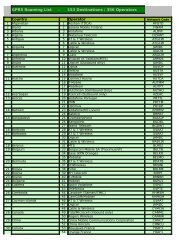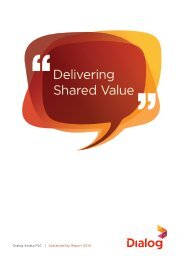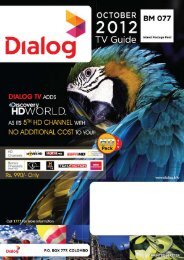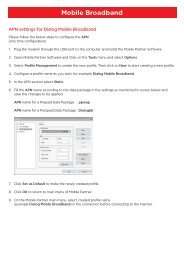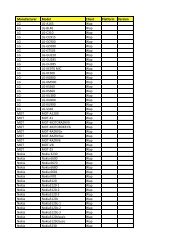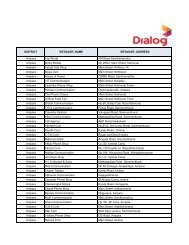Annual Report 2012 - Dialog
Annual Report 2012 - Dialog
Annual Report 2012 - Dialog
You also want an ePaper? Increase the reach of your titles
YUMPU automatically turns print PDFs into web optimized ePapers that Google loves.
58 l <strong>Dialog</strong> Axiata PLC l <strong>Annual</strong> <strong>Report</strong> <strong>2012</strong><br />
Notes to the Financial Statements<br />
2 Summary of significant accounting policies contd.<br />
2.1.1 Changes in accounting policies and disclosures<br />
New accounting standards, amendments and interpretations issued but not effective for the financial year beginning<br />
1st January, <strong>2012</strong> and not early adopted.<br />
(i) SLFRS 13, ‘Fair Value Measurement’ aims to improve consistency and reduce complexity by providing a precise<br />
definition of fair value and a single source of fair value measurement and disclosure requirements for use across<br />
SLFRSs.<br />
(ii) SLFRS 10, ‘Consolidated Financial Statements’, builds on existing principles by identifying the concept of control<br />
as the determining factor in whether an entity should be included within the consolidated financial statements of the<br />
parent company. The standard provides additional guidance to assist in the determination of control where this is<br />
difficult to assess. The Company and the Group is yet to assess SLFRS 10’s full impact.<br />
(iii) FRS 12, ‘Disclosures of Interests in Other Entities’, includes the disclosure requirements for all forms of interests<br />
in other entities, including joint arrangements, associates, special purpose vehicles and other off balance sheet<br />
vehicles. The Company and the Group is yet to assess SLFRS 12’s full impact.<br />
(iv) SLFRS 9, ‘Financial instruments’, addresses the classification, measurement and recognition of financial assets<br />
and financial liabilities and replaces the areas of LKAS 39 which relate to classification and measurement of financial<br />
instruments. SLFRS 9 requires financial assets to be classified in to two measurement categories at initial recognition<br />
which are financial assets measured as at fair value and financial assets measured at amortised cost. The<br />
classification depends on the entity’s business model for managing its financial instruments and the contractual cash<br />
flow characteristics of the instrument. For financial liabilities, the standard retains majority of the IAS 39 requirements.<br />
The main change being the fair value option taken as financial liabilities, the part of a fair value change due to an<br />
entity’s own credit risk is recorded in other comprehensive income in the statement of comprehensive income,<br />
unless this creates an accounting mismatch. The Company and the Group is yet to assess SLFRS 9’s full impact.<br />
2.2 Consolidation<br />
(a) Subsidiaries<br />
Subsidiaries are all entities (including special purpose entities) over which the Group has the power to govern the financial<br />
and operating policies generally accompanying a shareholding of more than one half of the voting rights. The existence<br />
and effect of potential voting rights that are currently exercisable or convertible are considered when assessing whether the<br />
Group controls another entity. Subsidiaries are fully consolidated from the date on which control is transferred to the Group.<br />
They are de-consolidated from the date that control ceases. The Group also assesses existence of control where it does<br />
not have more than 50% of the voting power but is able to govern the financial and operating policies by virtue of de-facto<br />
control. De-facto control may arise in circumstances where the size of the Group’s voting rights relative to the size and<br />
dispersion of holdings of other shareholders give the Group the power to govern the financial and operating policies, etc.<br />
The Group applies the acquisition method to account for business combinations. The consideration transferred for the<br />
acquisition of a subsidiary is the fair values of the assets transferred, the liabilities incurred to the former owners of the<br />
acquiree and the equity interests issued by the Group. The consideration transferred includes the fair value of any asset<br />
or liability resulting from a contingent consideration arrangement. Identifiable assets acquired and liabilities and contingent<br />
liabilities assumed in a business combination are measured initially at their fair values at the acquisition date.



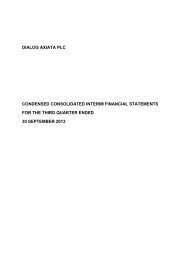
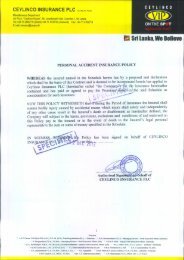
![nrypq;Nfh ,d;#ud;;]; nfhk;gdp ypkplw - Dialog](https://img.yumpu.com/15429071/1/190x245/nrypqnfh-dud-nfhkgdp-ypkplw-dialog.jpg?quality=85)
